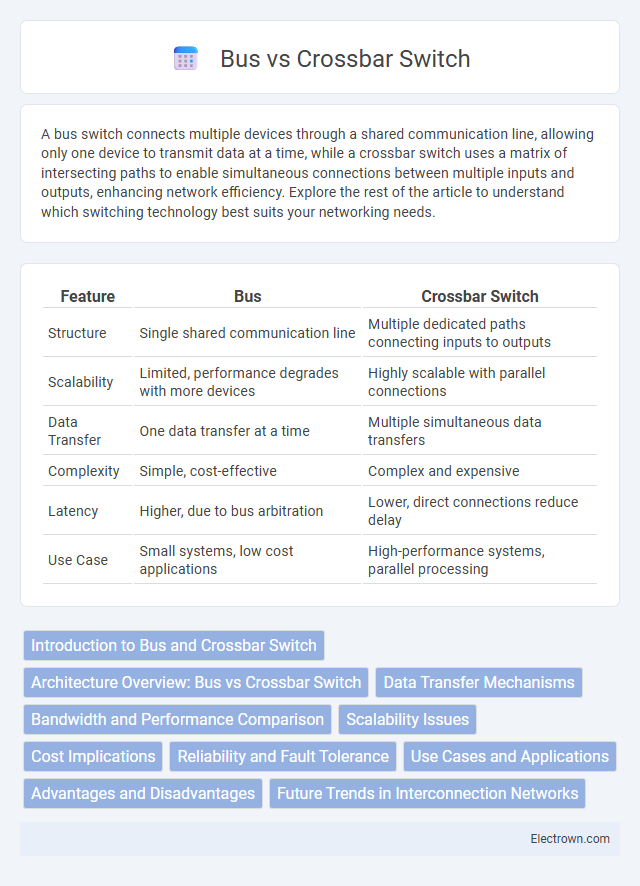A bus switch connects multiple devices through a shared communication line, allowing only one device to transmit data at a time, while a crossbar switch uses a matrix of intersecting paths to enable simultaneous connections between multiple inputs and outputs, enhancing network efficiency. Explore the rest of the article to understand which switching technology best suits your networking needs.
Table of Comparison
| Feature | Bus | Crossbar Switch |
|---|---|---|
| Structure | Single shared communication line | Multiple dedicated paths connecting inputs to outputs |
| Scalability | Limited, performance degrades with more devices | Highly scalable with parallel connections |
| Data Transfer | One data transfer at a time | Multiple simultaneous data transfers |
| Complexity | Simple, cost-effective | Complex and expensive |
| Latency | Higher, due to bus arbitration | Lower, direct connections reduce delay |
| Use Case | Small systems, low cost applications | High-performance systems, parallel processing |
Introduction to Bus and Crossbar Switch
A bus switch is a communication pathway that allows multiple devices to share a single data line, enabling one device to transmit data at a time while others wait in a sequential manner. A crossbar switch consists of a grid of intersecting horizontal and vertical lines with switches at each intersection, allowing multiple simultaneous connections between devices without data collision. Crossbar switches offer higher performance and scalability compared to bus switches in complex communication systems.
Architecture Overview: Bus vs Crossbar Switch
Bus architecture uses a single communication line shared by multiple devices, enabling data transfer one at a time, which can cause bottlenecks as device count increases. Crossbar switch architecture employs a grid of intersecting lines and switches, allowing multiple simultaneous connections between inputs and outputs, greatly enhancing data throughput and reducing contention. Your choice between bus and crossbar switch architectures impacts scalability and performance in systems requiring efficient data routing.
Data Transfer Mechanisms
Bus-based switches transfer data sequentially over a shared communication path, causing potential bottlenecks as multiple devices compete for the same bandwidth. Crossbar switches enable simultaneous parallel data transfers by establishing dedicated paths between multiple inputs and outputs, significantly improving throughput and reducing latency. This parallel data transfer mechanism in crossbar switches is ideal for high-performance computing environments requiring low contention and high data rates.
Bandwidth and Performance Comparison
Crossbar switches provide higher bandwidth by enabling multiple simultaneous connections between inputs and outputs, eliminating the contention issues typical in bus architectures. In contrast, bus switches share a single communication pathway among all devices, resulting in lower overall performance under heavy traffic due to bandwidth constraints. Your network's performance significantly improves with crossbar switches when parallel data transfer and low latency are critical.
Scalability Issues
Bus architectures face significant scalability issues because as more devices are added, the shared communication path becomes a bottleneck, leading to increased data collisions and reduced overall performance. Crossbar switches scale more effectively by providing dedicated paths between devices, allowing simultaneous data transfers without interference, which significantly improves throughput. Your network's expansion benefits from crossbar technology's ability to maintain high-speed communication even as the number of nodes increases.
Cost Implications
Bus switches incur lower initial costs due to simpler wiring and fewer components, making them economical for small-scale networks. Crossbar switches require higher investment owing to complex cross-point arrays and increased hardware, which scales quadratically with the number of ports. Maintenance and scalability costs also rise significantly for crossbar switches compared to bus systems, impacting overall total cost of ownership.
Reliability and Fault Tolerance
Crossbar switches offer higher reliability and fault tolerance compared to bus switches due to their multiple independent paths, allowing for alternate routing if one connection fails. Bus switches rely on a shared communication line, making them more vulnerable to single points of failure that can disrupt the entire network. Your system's fault tolerance significantly improves with crossbar switches, which isolate faults and maintain operation without affecting unrelated connections.
Use Cases and Applications
Bus switches are ideal for simpler, low-cost systems requiring limited simultaneous connections, such as basic memory modules or small embedded systems. Crossbar switches excel in high-performance environments demanding multiple concurrent data paths, like data centers, telecommunications networks, and advanced multiprocessing systems. Your choice depends on the complexity and scalability requirements of your application.
Advantages and Disadvantages
A bus switch offers simplicity and lower cost for small-scale networks but faces limitations in scalability and increased data collision risks as more devices connect, reducing overall performance. Crossbar switches provide faster, non-blocking communication with higher scalability, ideal for complex or high-demand systems, though they come with increased complexity and higher implementation costs. Your choice depends on balancing budget constraints, network size, and desired communication speed.
Future Trends in Interconnection Networks
Future trends in interconnection networks emphasize scalability and bandwidth efficiency, with crossbar switches evolving through optical and 3D integration technologies to overcome traditional bus limitations. Bus architectures struggle with contention and limited parallelism as core counts rise, making crossbars and their hybrid variants more suitable for high-performance, low-latency communication in multiprocessor systems. Your system's interconnect design will increasingly rely on adaptive, high-throughput crossbar topologies to meet the demands of emerging AI workloads and exascale computing.
Bus vs crossbar switch Infographic

 electrown.com
electrown.com